An old painting by John Miles of Northleach imagines Adam in the midst of naming all the animals in the Garden of Eden. Adam stands in the middle of the frame; the animals surround him waiting to receive their names. Unlike earlier versions that show Adam receiving just a few animals, Miles’ version captures the overwhelming scope of the task by lining up animals nose to tail back and forth across the scene like people waiting for the Jungle Cruise at Walt Disney World or in an understaffed passport control line. I have been where that lion in the foreground is. Stuck in an absurd, unmoving line, he has let go of his mind. He is past frustration, rage, and tears. He lies down next to a lamb, not in supernatural peace or out of any interspecies fraternity, but out of pure, absolute resignation and ennui. The king of the jungle has been reduced to one direct and knowing look: “you see what I’m dealing with here, right?” his eyes dimly blink. The tiger behind him is even worse off. Drape the tiger’s paw over a dead body, and he is the undead man at the edge of the Raft of the Medusa.
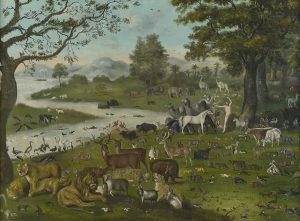 In contrast to these undone creatures, Adam works with manic glee. Standing at the head of the line, Adam names with the wild enthusiasm of a concert conductor. His gusto is surely fleeting though. At the moment Miles’s painting captures, Adam seems to have named four animals, all of them camels: a pair of Bactrians and a pair dromedaries. Soon enough, Adam’s gaze will lift from the animals directly in front of him off to the miles-long line of creatures that stretches over the arc of the horizon. As animal after animal paraded past him, the enormity of his task must have set in. Seeing a prairie dog twenty-five minutes after he had named the gopher would have set him off. “Haven’t I already named this thing?” he would have snapped, “Is somebody making sure that animals aren’t hopping back into line?”
In contrast to these undone creatures, Adam works with manic glee. Standing at the head of the line, Adam names with the wild enthusiasm of a concert conductor. His gusto is surely fleeting though. At the moment Miles’s painting captures, Adam seems to have named four animals, all of them camels: a pair of Bactrians and a pair dromedaries. Soon enough, Adam’s gaze will lift from the animals directly in front of him off to the miles-long line of creatures that stretches over the arc of the horizon. As animal after animal paraded past him, the enormity of his task must have set in. Seeing a prairie dog twenty-five minutes after he had named the gopher would have set him off. “Haven’t I already named this thing?” he would have snapped, “Is somebody making sure that animals aren’t hopping back into line?”
God, sensing Adam’s frustration, may have said, “Honestly Adam, everything in the line is distinct. There are no repeats. We’re about 26 names into 8 million species. So let’s just keep things moving, ok?”
“I have to do the plants too?”
“No, 8 million is just the animals. Plants would be another 400,000.”
Miles’s representation of Adam naming the animals rests on a solid biblical foundation. Genesis is clear that God rounded up the animals and “brought them to the man to see what he would call them.” This makes sense because the cattle chute approach is the only way that the project could have worked. Without the animals all lined up—if, for example, Adam had just walked around the Garden of Eden naming what he came across—he would certainly have seen and named only a handful of the most distinct species. He would have noticed those camels with their humps, but would he have seen that one set had one hump and the other had two. Would he have distinguished camels from alpacas? How about alpacas from llamas?
Adam’s problem of not being able to pick unnamed animals out of the tangle of life is our problem too. Names don’t just allow us to point something out to somebody else; they make things (animals, plants, acquaintances, friends) visible to us. Even Saint Augustine who argues that “we don’t learn anything by means of these signs called words,” admits that words direct our attention and “have force only to the extent that they remind us to look for things.” Without a particular name to lift an insect, a flower, or a bird out of its background, color may flash in front of our eye or sound may buzz our ear, but, more often than not, these sensations will be nothing more than fleeting impressions—if we perceive them at all. We see and we remember at the level of particularity we can name. Until very recently I have encountered my farm no more particularly than as “field,” “flower,” “tree,” “bird,” “bug,” and “grass.” I am concerned about this general understanding of my farm because I affirm Aldo Leopold’s observation that “We can be ethical only in relation to something we can see, feel, understand, love, or otherwise have faith in.” How can I love something that I cannot even call by name?
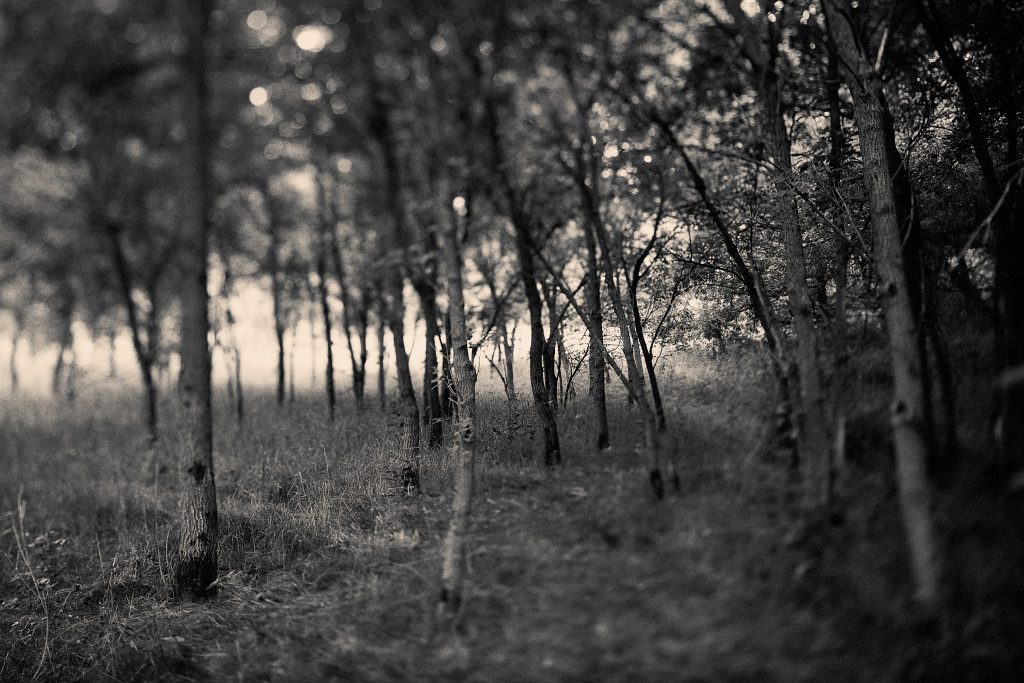
On my tax bill, the county calls the back fourteen acres of my farm “G5M – Agricultural Forest,” which means that these acres are “capable of producing forest products.” This designation is both meaningless and useful to me. Unlike the acre and a half that surrounds my house (“G7 – Other”) and the nine and a half acres of barn, lawn, and orchard that surrounds that (“G5 – Undeveloped”), the county taxes these fourteen acres of “Agricultural Forest” at a discount of fifty percent of their value. Not all forests are the same in the county assessor’s eyes. I am eager not to have my fourteen acres of G5M confused with “Timber Tract Operations,” “Forest Nurseries,” “Game preserves,” or “Hunting Preserves.” All of which are assessed at 100% of their value.
No matter what the county says though, I cannot bring myself to refer to our back fourteen acres as a “forest.” To me, a forest is a million and a half acres of Chequamegon birch, tamarack, and pine or a million and three quarter acres of Baker-Snoqualmie hemlock, fir, and huckleberry. Beyond my so-called “Agricultural Forest’s” modest acreage, it doesn’t really have enough trees to be a forest, and it certainly doesn’t have enough nice trees to be considered capable of producing forest products. This is not to say that it isn’t a really charming part of our farm, just that forest is to my fourteen acres as a name like Eleanor is to an eighteen-month-old girl. So I just call our forest the woods.
These woods are actually a combination of trees and grass. A small meadow about twenty paces wide and fifty paces deep functions as something of a vestibule. In summer, trees and dense, prickly underbrush line this anteroom on two of its sides. Another line of bushy trees run along a sagging, rusty barbed wire fence and form its third wall. There is no fourth wall; the meadow just spills out into the barnyard and up the modest slope where our orchard is limping along. We’ve recently started calling this field “Moonrise Meadow” after the oversized ivory moons that rise up out of it a couple of times a month. Though fitting, the name is still too new to feel quite right; it’s perhaps a little too Age of Aquarius for our modest Wisconsin farm. The name is like a brand new pair of leather hiking boots: only time will tell if the name just needs to stretch, mold, and acquire a patina from regular use or if it’s been the wrong shape and size from the get go. Rather than play Adam, I’d much rather find and pick up an old name for this field. Best of all would be some dead metaphor that has long outlived its most immediate referent.
We have one of these names dying on our farm right now. For the growing seasons of each of the past twenty years and for seven of the ten months that we have lived here, our neighbor Larry has grown beans and corn on the fourteen tillable acres south of the farmhouse. Whenever we refer to that field, we call it “Larry’s field,” even when it is cleared of his beans. Unlike the “moon meadow” which was deliberately chosen, “Larry’s field” has grown unconsciously and therefore perhaps more organically out of the history of the farm. It’s a working name, not a literary one. I suspect the field will remain “Larry’s Field” in name long after it has ceased being Larry’s by handshake contract.
The entrance to the woods hides in the back left corner of the moonrise meadow. Like the low, hidden doors to Frank Lloyd Wright’s prairie houses, the entrance to the woods is visible only upon approach. From the middle of the meadow, overlapping planes of branches and brush suggest an unbroken wall of woods. The entrance would be visible from the barbed wire fenceline, but overhanging branches prevent anyone from standing close enough to the fence to see from this perspective. I’ve thought of pruning these branches, but I like the way that they force anyone approaching the woods to zig and zag as they would around concrete bollards at contested borders and security checkpoints. After the last overhanging limb, the entrance presents itself as a funnel.
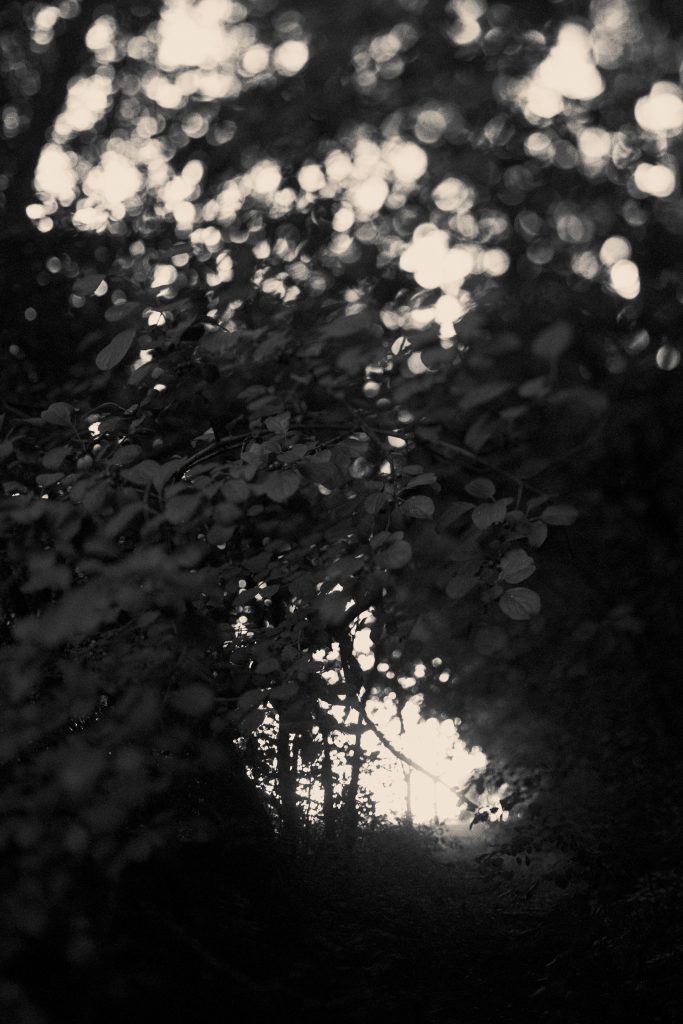
This entrance is a timber groin vault of limbs and leaves that gives the impression of stepping into dense, dark wood. After just twenty-five paces, though, this low, interleaved canopy opens back up to sky filtered every ten or fifteen feet by immature trees that are colonizing their way across an old meadow. Most of the trees are about the same age, and their trunks are neither smaller in circumference than a teacup nor greater than a saucer. In late summer, chest-high, ripe grass grows between these trees. This is no oak savanna though. The trees’ trunks are spaced just over an arm span apart and the grass is losing this battle in its prairie war. Within a couple of years the trees will cast enough shade to stunt the grass and to welcome woody underbrush.
A previous owner cut a trail through the grass and trees, and I continue to mow according to the route he established. Just after the vault, his trail forks and offers a choice of two paths around this young grove. To the right, the trail bends around back of this fading meadow, into denser woods and undergrowth. To continue straight is to follow the property line into grass-held territory. A few trees have helicoptered into the grass behind the front line and have established a solid timber beachhead amongst the grass, but grass still dominates. This clearing in the middle of our woods is a rounded rectangle about seventy paces wide from the tree colony to a much older line of trees that grew up as a hedge between my farm and my neighbor’s. The rectangle clearing is about 200 paces long, though these 200 paces wind from the top of a hill to the property line in front of my neighbor’s cornfield along the meandering diagonal that the trail cuts through the grass. In these 40,000 or so square yards, two dozen trees break the line of sight over the grass.
One sunny June morning my six-year-old son Peter and I walked out to the woods to identify some of these trees. We took Stan Tekiela’s Trees of Wisconsin with us. It is a slim, pocket-sized and novice-friendly field guide. On the last of the Roman-numeraled pages, Tekiela provides a simple key that guides readers through the steps of identifying trees. In just four decisions based upon the organization and shape of leaves—conifer / deciduous, simple leaf / compound leaf, lobed/not lobed, alternate / opposite—Tekiela brings his readers to a few pages of pictures that they can make a final comparison to a leaf, a fruit, or some bark.
Peter and I tested out the key with the trees along the Moonrise Meadow’s fence line before we entered the woods proper. The first decision was the easiest, and I let him take the lead with the dichotomies. After choosing deciduous over conifer, we had to decide between “simple” and “compound” leaf arrangement. Bunches of leaves came out of whippy branches, but neither Peter nor I could tell if these were simple leaves grown close together or leaflets along a single stalk. The line between branch and stalk is a blurry one, but choosing correctly was absolutely essential if we were to proceed past the key’s second dichotomy. We flipped back and forth between pages of simple leaf photos and compound ones, and finally decided that the leaf we held had to be simple. We followed the rest of the key (Simple, No Lobes, Alternate Leaves) to the photos of Poplars, Birches, Willows which we all rejected out of hand as familiar, but not at all close to the tree we were looking at. Eventually we thumbed to the final choice: Red Mulberry or White Mulberry. The trees are so similar, writes Tekiela, that “the only time it is easy to differentiate them is when there is fruit on the trees.” It was mid-June, and there was indeed fruit on this tree. It looked exactly like the red berries pictured in the photograph of Red Mulberries. It also looked exactly like the red berries in the picture of White Mulberries. Most of the berries were apparently not yet ripe. A few, higher up in the tree and farther out towards the meadow’s sunshine had started to turn from pinkish red to crimson, and a few of these had even started to blacken at their bulbous tips. Black is Red Mulberry’s tell.
Tekiela’s publisher’s lawyers must have insisted upon a warning at the end of Trees of Wisconsin’s introduction: “CAUTION,” they write, “In Stan’s notes, it’s occasionally mentioned that parts of some trees were used as medicine for food. While some find this interesting, DO NOT use this field guide to identify edible or medicinal trees. Certain trees in the state have toxic properties or poisonous lookalikes that can cause severe problems . . . Enjoy the Trees! Stan.”
Stan cautions against using the guide to identify edible tree fruit. He does not consider the inverse, using (hopefully) edible fruit to identify a tree. To this point, Peter and I had used only our eyes to identify this Mulberry. Definitive proof would seem to be in one of those blackening berries. Among the features Stan lists (20-30’ tall, gray to reddish brown bark with uneven furrows, simple oval to multi-lobed leaf with coarse toothed margin) one feature requires direct physical contact to test: “. . . berries ripen to red and are delicious when black. Fruit is sweet and juicy. . .” I reached high up into the tree, grabbed the end of a branch and bowed it down so that I could grab one of the blackest berries on the tree. I plucked it off, rolled it around between my thumb and index finger and popped it into my mouth. Wary of the bitter taste that was sure to presage gastric distress, I tentatively crushed the berry onto the roof of my mouth with my tongue. When the berry burst, treacle unalloyed with even a hint of tartness oozed across my tongue. It was artificially sweet, like boysenberry syrup at IHOP or a neat shot of the flavor baristas pump into lattes. Peter watched my expression as I tasted: “How is it?” he asked anxiously.
“It’s ok,” I lied, wanting to let whatever poison might be present work its way to my stomach before I tempted my son with a forbidden fruit.
“So it’s a Red Mulberry?” he asked.
“Yeah, it’s a Red Mulberry.”
I closed the guide and began to look around for something else to identify.
Peter wasn’t finished though: “Can you lift me up so I can get a leaf?”
“Sure” I said. I lifted him up by the waist. He plucked a handful of leaves off the end of the nearest branch. When I set him down, he chose the most perfect one and traced it into his eight-by-eleven-inch sketchbook. After he traced the leaf’s outer edge, he carefully transferred the veins and shaded the leaf’s waxy cuticle. Peter then surrounded his traced leaf with four circles. He drew four lines from the circles to different parts of the leaf. He filled only one of the circles. This one has a wavy line that seems to be a magnified view of the leaf’s serrated margin. I do not recall whether the other boxes went unfilled because he lost interest or because I lost patience. I do know that I say, “let’s keep moving buddy” like a refrain on too many of our adventures.
We repeated the identification process at the first tree we encountered once we had stepped through the vault and into the woods proper, working our way through the key to “Boxelder.” I knew boxelders like I knew buckthorn and garlic mustard. They are invasive plants. I’ve used them as examples in lectures and as metaphors in essays. Until Peter and I identified this particular boxelder, though, the tree was a mere figure. I couldn’t distinguish one as an actual species in the woods. I was pleased to learn the name of another of my farm’s trees, but I was disappointed to learn that it is a boxelder. Months earlier, a USDA extension officer came out to the farm to help us with a plan for our tillable acreage, lawn and woods. When we were walking the margin between field and woods, she confirmed my initial, academic prejudices against boxelders. She pointed out a boxelder, and I asked, “They’re pretty invasive, aren’t they?”
“Oh yeah,” she replied, “and they’re really just trash trees.”
Tekiela takes a similar but more nuanced position. A boxelder is “A member of the maple tree with all the virtues, but none of the respect,” Tekiela writes in Trees of Wisconsin. It is “often thought of as a trash tree, but it produces large amounts of seeds which stay on the tree throughout winter making a valuable food source for wildlife.”
Peter and I stepped up to a third tree and began working our way through the key again. It took just three decisions for us to realize that we were looking at another boxelder. After this experience, which was nearly as embarrassing as introducing myself to a person twice at the same party, I could confidently identify and name boxelders of any age or size. Now that I recognized them, I saw them everywhere: thin, ambitious ones trying to gain a foothold amongst older siblings; thick-trunked ones standing all alone; old ones with shattered limbs leaning into the grass. All of the trees that were colonizing the meadow in the grove.
Prior to identifying the meadow trees as boxelders, I had been torn between thinning out the meadow for aesthetic purposes—to enlarge the prospect from the top of the hill out over the grass—and preserving trees out of a sense of ecological duty. The inclusion of boxelder in Elizabeth Czarapata’s Invasive Species of the Upper Midwest relieved me whatever of anxiety and guilt remained about chopping them down though, and I began mentally erasing them from the meadow. Czarapata lists boxelder in her “Native Plants That Sometimes Need Control” chapter and notes that they are not strictly “invasive” because they are in fact endemic to Wisconsin. Though they are technically native, boxelders are aggressive and are sometimes problematic colonizers of disturbed soil.
Thus assuaged, Peter, Nora, and I have spent several mornings sawing. My kids love chopping down trees. I do too. We haven’t yet figured out how to safely use the chainsaw, so we do all the work with an axe and a Christmas tree farm bow saw that Peter calls the “two-man saw.” He and I each grab an end of it like two nineteenth-century lumbermen or a pair of Leopolds. A sticker on the handle of my axe clearly identifies it as a “boy’s axe.” Though a boy, Peter is too small to wield the axe, so I do all of the delimbing myself. The twenty trees that dot the clearing are five fewer than when we bought it. At some point, maybe this spring, we will clear away some of the meadow’s grass and plant a burr oak that can spread out in prairie splendor. Other than the circle of turf that we’ll clear away for the baby oak, we are not sure about what to do with the rest of the grass in the clearing.
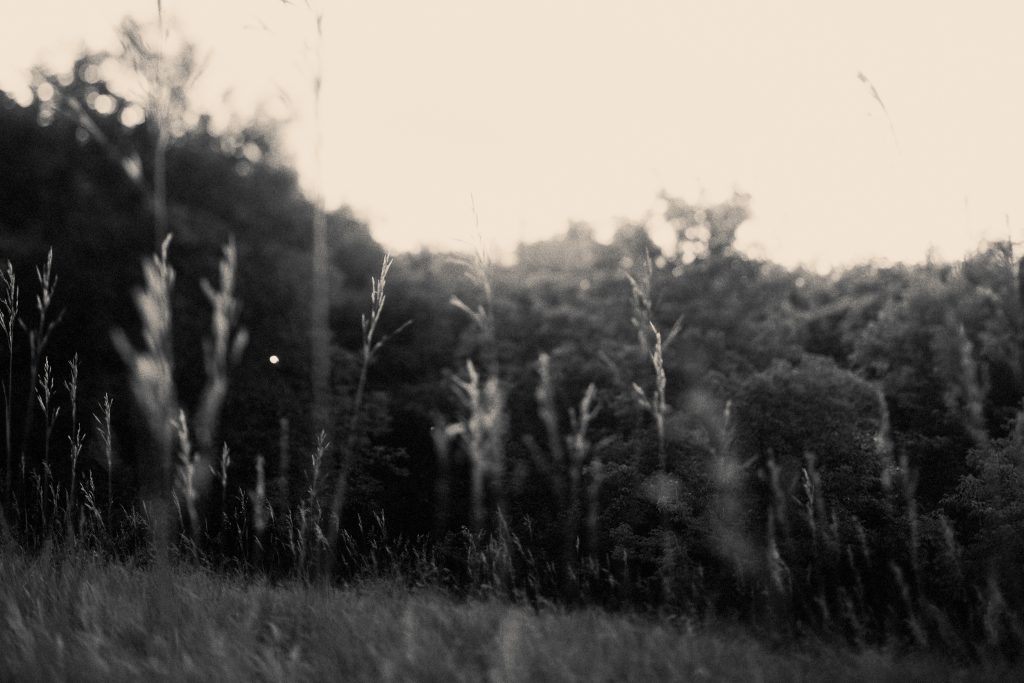
The same extension officer that identified the boxelders and labeled them trash trees pointed out several really persistent species of invasive grass, but I forgot to make either mental or written notes about them. A few months later, I checked out Emmet J. Judzeiwicz, et al.’s Field Guide to Wisconsin Grasses in the hope that I could identify some of the species in the clearing. I had been buoyed by my success with Trees of Wisconsin, and I opened the guide to grasses confidently and eagerly. After the obligatory acknowledgements and other front matter, the book opens with the most basic question, “What is a grass?” their answer to this crucial question begins “A grass is an herbaceous plant in the family called the Poaceae.” Of the twelve words in that sentence, I understood ten without recourse to a dictionary. So far, so good, I thought. The wheels came off about halfway through the second sentence:
Grasses are differentiated from all other plants by their possession of a compound inflorescence of discrete, small inflorescences called spikelets, usually composed of two glumes and one to many florets, each floret usually composed of a lemma and a palea enfolding a tiny flower that matures into a fruit called a grain or caryopsis.
After this preliminary definition, which would have been no less illegible to me if it had been written in Cyrillic script, Grasses of Wisconsin turns to a cheerful distinction of grasses from sedges in three comparison photographs. To my untrained eye, the photos of grasses’ and sedges’ “culms (stems),” leaves, and blades look exactly the same. Rachel Carson quotes Keats’s “La Belle Dame Sans Merci” as an epigraph for Silent Spring: “The sedge has withered from the lake / And no birds sing.” I get the gist of the lines, but still have no idea what a sedge is. I pulled the Field Guide to Wisconsin Sedges from my university library and found it to simply be a negative of Grasses of Wisconsin.
Daunted, I skipped 58 pages of terminology and the history of grass classification to cut right to the keys. I was not encouraged by what I found. Under the heading “What Features Must I Look at to Identify an Unknown Grass,” Judzeiwicz, et al. warn, “Learning to identify grasses is challenging and requires a significant investment of time.” Before proceeding to the keys and to the descriptions of actual grasses, Judzeiwicz, et al. provide a key to the abbreviations they use to identify features in grass photographs. I did not understand a single one of the features; in fact, several of the words looked like typos or silly words made up by a four-year-old:
- AN…..anther
- AW…..awn
- LI…….ligule
- PA……palea
- RA……rachilla
- UG……upper glume
My confusion at the most basic terms of identification did not augur success with the keys; even so, I was not prepared for how thoroughly disorienting they would be. Not only could I not identify or distinguish between any of the features in question, I couldn’t even figure out how the key worked. Unlike Tekiela’s simple dichotomies, the first key in The Grasses of Wisconsin presented several layers of subordinated distinctions. I was prepared for a choose-your-own adventure through the wonderful world of grasses, but this was an outline with questions and sub-questions and sub-sub-questions that looked like David Foster Wallace footnotes. The key was more tangled and impenetrable than a mat of prairie turf, and I abandoned it. For the foreseeable future, the grass in my clearing will have to remain grass.
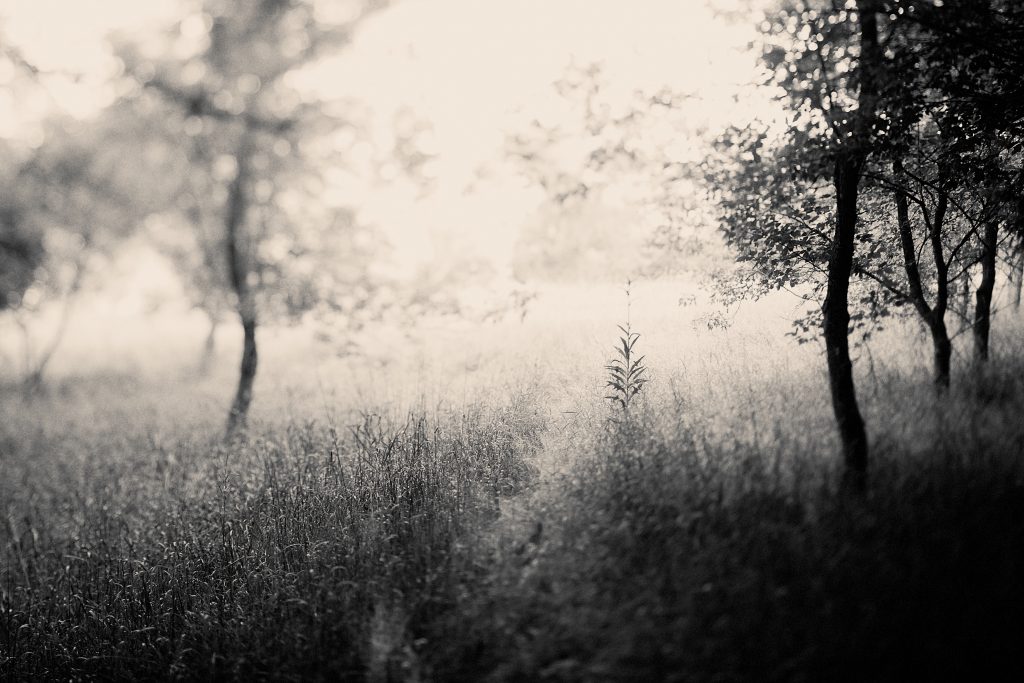
In early September, Tiffany and Josh Kriner invited my family and me to visit them at Root and Sky Farm in Marengo for a tour and dinner. The visit was a reciprocal one, made after the Kriner family made the opposite two-hour drive up I-90 to visit our farm on a hot, humid, and buggy afternoon two months earlier. Their Root and Sky Farm and our Pied Beauty Farm exist as near mirror images of each other. Both were rundown, intensively farmed homesteads. Both have been taken over by English professors and their farmer spouses with the hope of restoring the land and doing good with it. The farms are named after poems whose lines are almost interchangeable: “In our fields, fallow and burdened, in grass and furrow” begins the namesake of one; “Landscape plotted and pieced—fold, fallow, and plough,” sings the other.
Kerstin, Peter, Nora, and I left Stoughton for Marengo on a Friday afternoon with what I thought was a clear picture of Root and Sky farm. Though this was our first visit, I had read about it on Tiffany and Josh’s blog. I had peered down on it from miles above with Google maps’ satellite view. I had clicked through the photos on the farm website. On the drive down, Google Maps’ blue dot guided me on a route that involved just a handful of turns over about 75 miles; even with the navigation assistance, I sailed past Root and Sky’s driveway by 500 yards. Once I realized my mistake and doubled back, I ditched the phone to keep all eyes on mailbox numbers. We found the drive and turned up it; nothing looked familiar. I was genuinely relieved when Tiffany came out of the house to greet us instead of some shotgun-wielding stranger. Just as Kerstin and I deadlifted our sleeping children from their car-seats, Tiffany’s husband, Josh, and their nine-year-old son Becket stepped out of the woods carrying five-gallon pails of husked walnuts.
We chatted for a few minutes about school and the weather, and then Tiffany asked if we would like to have a tour. “Of course,” we said. We walked an old road up a slight hill into the woods. Just under the canopy, we encountered the herd of pigs feeding on the weeds that overtake woods that grow out of old fields. Josh brought a pail of feed with him and began filling up the pigs’ fluted feed dishes that looked like oversized brioche tins. Beckett reached carefully over the electric fence to pet one of the hogs as it ate. My children hid behind Kerstin and my legs, at once terrified and fascinated. Just out of earshot, I asked Tiffany if she thought it would be hard for Becket when the time would come to slaughter the pigs. “No,” she replied, “I think he’ll be all right. It’s more Josh I’m worried about. He’s worked so closely with them all summer.”
“Do they have names?” I asked.
“Only one of them has a name, kind of. A friend named that one over there after himself.”
“Weird.”
“Yeah. He did say that we can’t eat that one though.”
“That makes sense.”
I had more than an academic interest in the pigs. When the Kriners’ visited our farm in July, we bought one half of one of their Berkshire hogs. Then, two weeks before this visit, Josh sent us a form that requested “cutting instructions.” Josh’s request sat in my email inbox for a week until Kerstin and I worked through the choices at our kitchen table. As we talked through the options, we referenced a couple of our favorite (mostly French) cookbooks and an image of a pig with dashed white lines superimposed across its body. Standing in the woods, just across a temporary electric fence from the pigs, I had no inclination to throw dashed lines across their hides. The thought of the pigs as pork didn’t even occur to me. These were beautiful, gentle, sensitive creatures.
Our emailed reply to Josh’s request determined that when we saw one of Root and Sky’s nameless, but hardly anonymous, hogs again, it would be halved into
- Four shoulder roasts—about 3 lbs each
- Two SMOKED Ham Roasts
- Fresh Jowl
- Breakfast sausage
- 2-3 boneless roasts about 3 lbs each, .75 tenderloin, 1 slab of baby back ribs
- Fresh whole belly—3 packs about 2.5 lbs
- Fresh Hock
- Fat & Skin
Not all that much verbal connective tissue or culinary skill is required to transform Josh’s cutlist into an echo of Ben Jonson’s old poem “Inviting a Friend to Supper:”
Yet shall you have, to rectify your palate,An olive, capers, or some better salad
Ushering the mutton; with a short-legged hen,
If we can get her, full of eggs, and then
Lemons, and wine for sauce; to these a cony
Is not to be despaired of, for our money;
And, though fowl now be scarce, yet there are clerks,
The sky not falling, think we may have larks.
I’ll tell you of more, and lie, so you will come:
Of partridge, pheasant, woodcock, of which some
May yet be there, and godwit, if we can;
Knat, rail, and ruff too.
It matters quite a lot that we received “jowl” (for guanciale), “fresh whole belly” (for our own bacon and for roasted crispy pork belly), and “Fat & Skin” (for pie crust and for scratchings), rather than a bulk load of “70 pounds of pork.”
That night we had a meatless dinner. The hogs were still in the woods feasting on grain instead of being feasted upon, pigs not yet translated into pork. Tomatoes, though, were in season and abundant. We stood around the kitchen counter chatting as Tiffany sliced them for bruschetta. She pulled them off a platter one by one, no two alike in color or shape. “What are they called?” I asked as she sliced. Tiffany named Green Zebras, Cherokee Purples, Garden Peaches, and Polish Luisas. “It has been a good year for tomatoes,” she said, “God has been good to us.” I smiled, grateful for the variety and glad that I was responsible only for receiving the already-named fruit.
The photographs in this post were taken by Jonny Hoffner, a photographer based in Madison, Wisconsin. He and his wife are co-owners of Paper Antler.

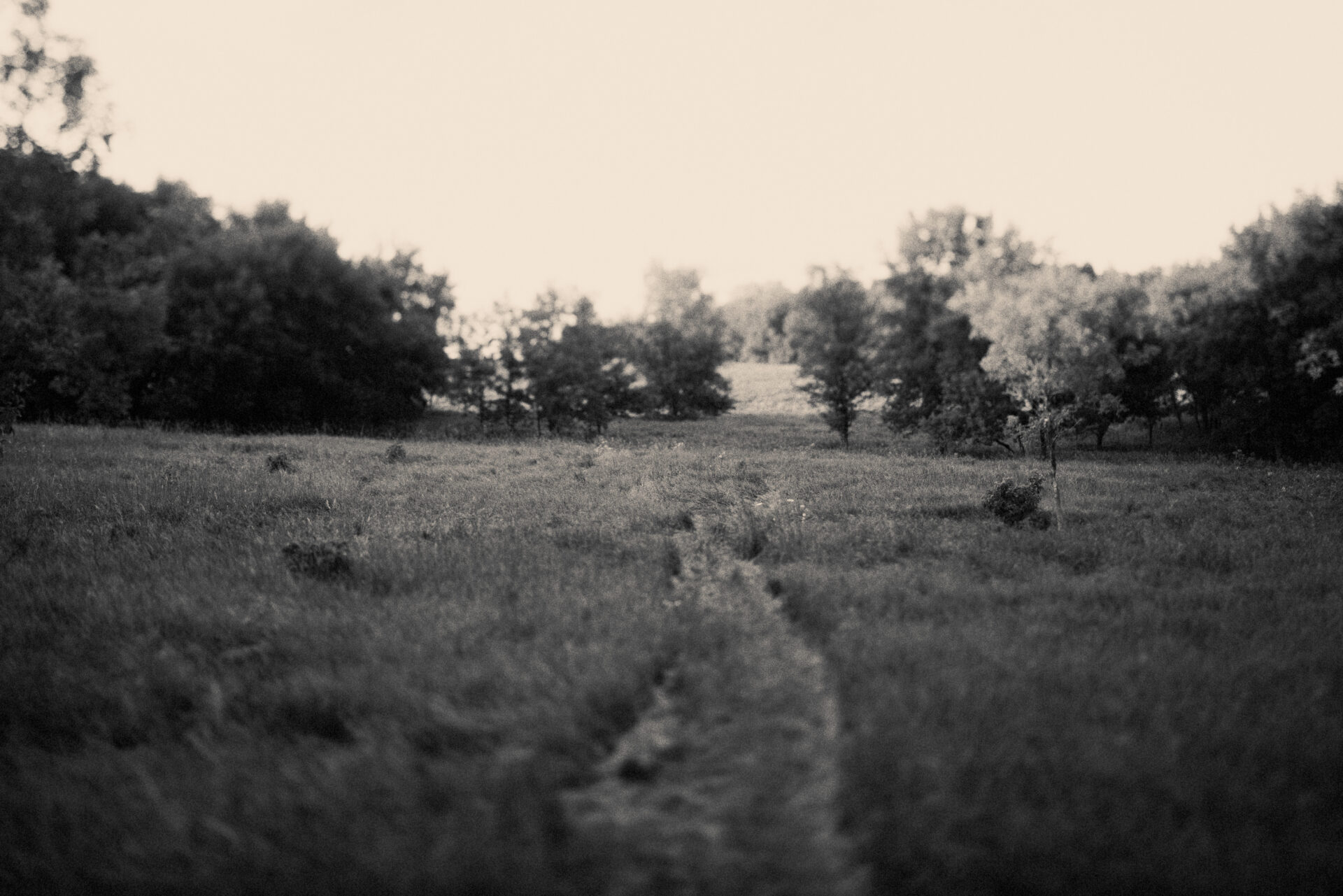


1 comment
Grant
Thanks for the article, Joshua. I was inspired to guide my girls in naming the trees in our yard (all three of them).
Comments are closed.